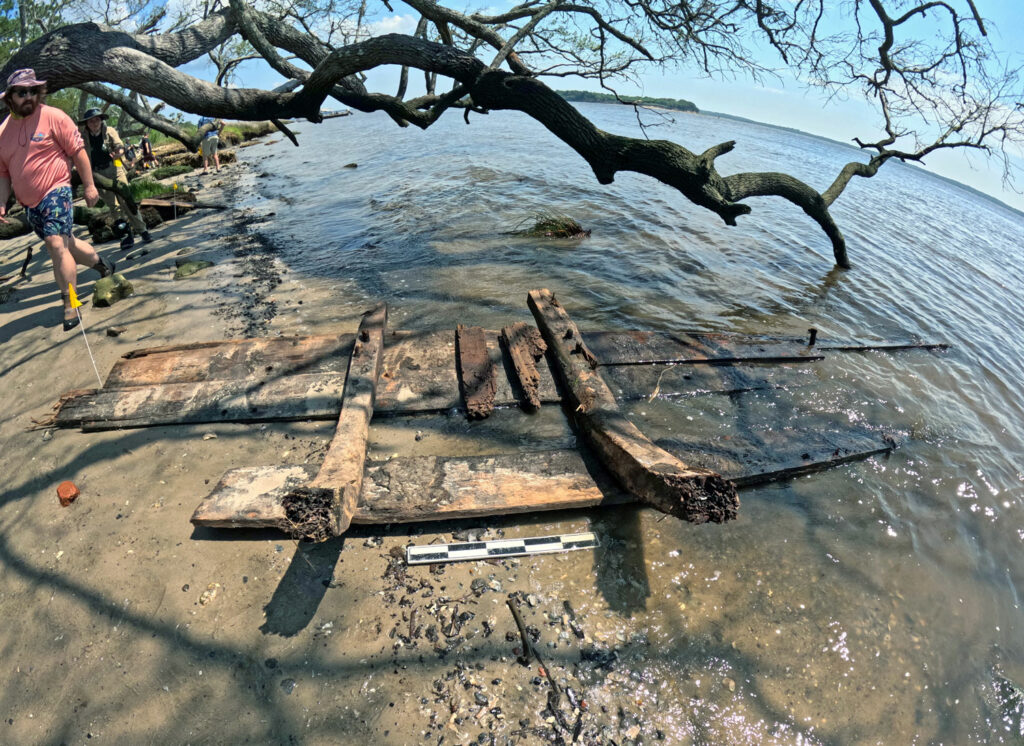Wreck of Spanish Privateer Identified in North Carolina
- archaeology.org language
- 2025-08-08 00:00 event
- 2 months ago schedule


Domain FALEARN.com for sale! This premium domain is available now at Kadomain.com

An unprecedented grouping of rare bipyramidal ingots has been discovered in the Sava River in Tolisa, northeastern Bosnia and Herzegovina near the border with Croatia. This shape of ingot dates them to between the La Tène culture and the beginning of the Roman era, the 2nd or 1st century B.C., and is exceptionally rare in … Read the full post →"Largest group of bipyramidal ingots found in Bosnia"
A rare brooch dating to the late Migration Period (475-550 A.D.) has been discovered in Kemi, Lapland, northern Finland. The gilded bronze fibula is engraved with stylized zoomorphic figures. It is a unique find for Finland. The brooch is 2.6 inches long with extensive surviving gilding in the front. The back may have originally been … Read the full post →"Iron Age gilded brooch found in Finland"
PARIS, FRANCE—When Napoleon marched his Grand Army of 600,000 troops into Russia in 1812, he […] The post New DNA Analysis Reveals Maladies That Ravaged Napoleon's Troops appeared first on Archaeology Magazine. News, disease, DNA analysis, Grand Army, Lithuania, Napoleon, paratyphoid fever, relapsing fever, Salmonella enterica serovar Paratyphi C, Vilnius
ULPIANA, KOSOVO—Vox News Albania reports that Kosovan Minister of Culture Hajrulla Çeku announced that a […] The post Mosaic Inscription Connects Justinian to Ancient City in Kosovo appeared first on Archaeology Magazine. News, basilica, Byzantine, inscription, Justinian, Justiniana Secunda, Kosovo, Theodora, Ulpiana
POMPEII, ITALY—When Mount Vesuvius erupted in a.d. 79, it famously buried Roman towns around the […] The post Some of Pompeii's Residents Returned Home After Vesuvius Eruption appeared first on Archaeology Magazine. News, eruption, Italy, Mount Vesuvius, Pompeii
The Russian Provisional Government of 1917, really a series of unelected coalitions, briefly held power from March to November, that is between the abdication of Tsar Nicholas II (reign 1894-1917) and the Bolshevik Revolution led by Vladimir Lenin (1870-1924). Lacking legitimacy from the outset and without the backing of the army, the government faced a series of severe crises, not least of which...
New excavations at Pompeii have uncovered archaeological evidence that the city was reoccupied after its destruction in the 79 A.D. eruption of Vesuvius. Former residents of the city who had no resources to move away and likely wanderers from other locations made homes for themselves in the ruins of the upper floors of buildings that … Read the full post →"Pompeii reoccupied for 4 centuries after its destruction"
RIVER BEND, WYOMING—In the 1970s, archaeologists conducting a salvage operation prior to construction discovered a […] The post Adornment Assemblage Linked to Wyoming Native American Site appeared first on Archaeology Magazine. News, adornment, awl, European contact, Native American, River Bend, Shoshone, Wyoming
VICTORIA, AUSTRALIA—The Conversation reports the results of a new study that has solved the mystery […] The post First Nations Ancestors Created Finger Grooves in Australian Cave appeared first on Archaeology Magazine. News, Australia, cave, finger grooves, First Nations, Gunaikurnai, mulla-mullung, New Guinea II
BRUNSWICK TOWN, NORTH CAROLINA—According to a statement released by East Carolina University, a team from […] The post Wreck of Spanish Privateer Identified in North Carolina appeared first on Archaeology Magazine. News, Brunswick Town, colonial America, Fort Anderson, King George's War, La Fortuna, North Carolina, shipwreck
Thomas J. Jackson (1824-1863), better known as Stonewall Jackson, was one of the most famous Confederate generals of the American Civil War (1861-1865). A veteran of the Mexican-American War and a former VMI instructor, he joined the Confederate army in 1861 and rose to prominence in his Shenandoah Valley Campaign (March to June 1862). He became the right-hand man of General Robert E. Lee (1807-1870...
How Important was the French Revolution? JamesHoare Thu, 08/07/2025 - 08:38
A socketed sickle of British manufacture has been discovered at the Suret site in Val-de-Reui in France’s lower Seine valley. The sickle dates to the Atlantic Late Bronze Age (1200–600 BC) and is a very rare find in France, one of only ten known. The sickle is made of copper alloy and is complete, although … Read the full post →"Late Bronze Age British sickle found in France"
LAODICEA, TURKEY—Turkish archaeologists unearthed a remarkably well-preserved ancient assembly hall in Laodicea that functioned as […] The post Roman Assembly Hall Unearthed in Ancient Anatolian City appeared first on Archaeology Magazine. News, Anatolia, assembly hall, Laodicea, theater, Turkey
GOA, INDIA—The Indian Express reports that construction work near the Basilica of Bom Jesus in […] The post Former Portuguese Colonial Arsenal Excavated in India appeared first on Archaeology Magazine. News, Albuquerque, arsenal, cannonballs, Goa, India, Portugese conquest
COOKHAM, ENGLAND—When University of Reading archaeologists began excavating a cemetery at an eighth-century Anglo-Saxon monastery […] The post Anglo-Saxon Monastery Was England's Earliest Hospice appeared first on Archaeology Magazine. News, Anglo Saxon, cancer, cemetery, Cookham, England, hospice, monastery
Soviets, often called Soviets of Workers' Deputies, were worker councils first formed during the Russian Revolution of 1905 when a general strike was called against the Tsarist regime. Factory and other types of workers across the newly industrialised Russian Empire elected some of their number to manage the strikes and represent worker interests, such as improving working conditions and pay. Soviets...
What’s in a Pope’s Name? JamesHoare Wed, 08/06/2025 - 09:03
An excavation in Topolovgrad, Bulgaria, has unearthed the tomb of a Thracian warrior and his horse so richly furnished that archaeologists think he was a local ruler. The burial dates to the second half of the 2nd century B.C., and the goods in his grave are so exceptional in craftsmanship and materials that it is … Read the full post →"Richest Hellenistic Thracian grave in Bulgaria found"